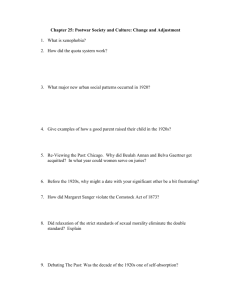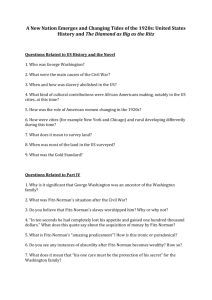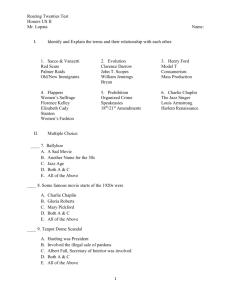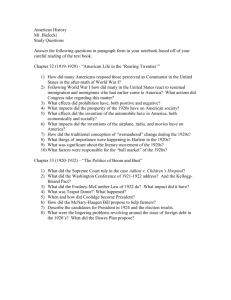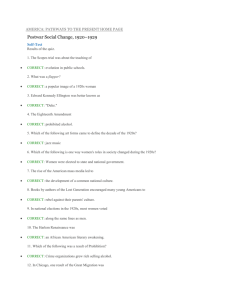Chapter 24—The New Era, 1920-1929 MULTIPLE CHOICE 1. For
advertisement
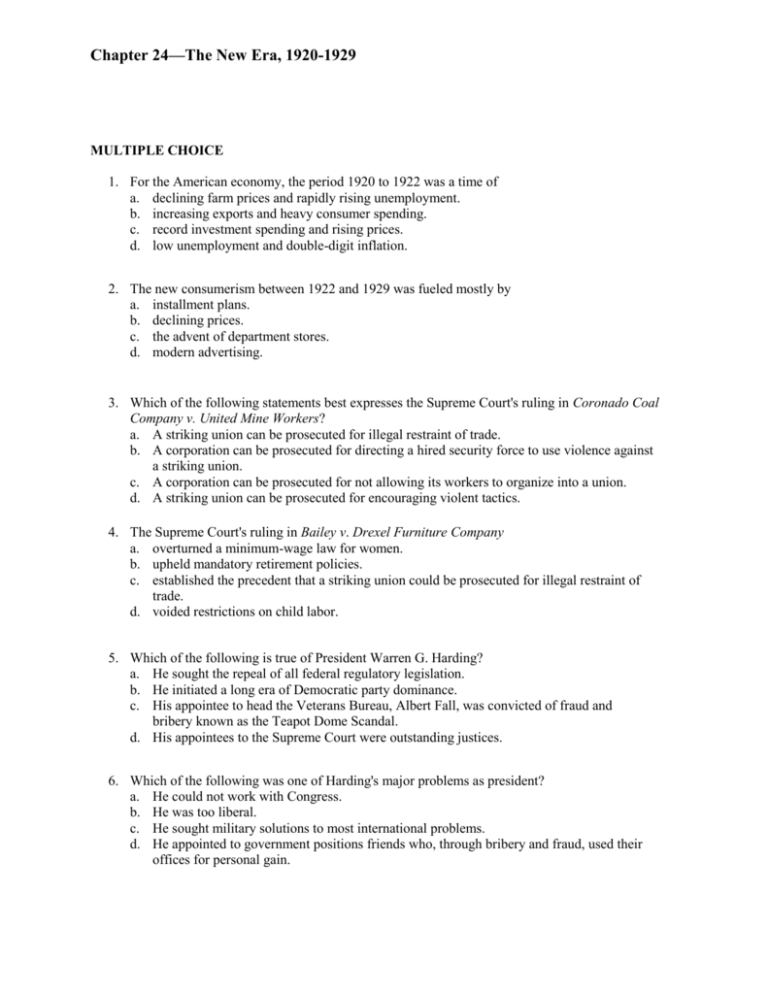
Chapter 24—The New Era, 1920-1929 MULTIPLE CHOICE 1. For the American economy, the period 1920 to 1922 was a time of a. declining farm prices and rapidly rising unemployment. b. increasing exports and heavy consumer spending. c. record investment spending and rising prices. d. low unemployment and double-digit inflation. 2. The new consumerism between 1922 and 1929 was fueled mostly by a. installment plans. b. declining prices. c. the advent of department stores. d. modern advertising. 3. Which of the following statements best expresses the Supreme Court's ruling in Coronado Coal Company v. United Mine Workers? a. A striking union can be prosecuted for illegal restraint of trade. b. A corporation can be prosecuted for directing a hired security force to use violence against a striking union. c. A corporation can be prosecuted for not allowing its workers to organize into a union. d. A striking union can be prosecuted for encouraging violent tactics. 4. The Supreme Court's ruling in Bailey v. Drexel Furniture Company a. overturned a minimum-wage law for women. b. upheld mandatory retirement policies. c. established the precedent that a striking union could be prosecuted for illegal restraint of trade. d. voided restrictions on child labor. 5. Which of the following is true of President Warren G. Harding? a. He sought the repeal of all federal regulatory legislation. b. He initiated a long era of Democratic party dominance. c. His appointee to head the Veterans Bureau, Albert Fall, was convicted of fraud and bribery known as the Teapot Dome Scandal. d. His appointees to the Supreme Court were outstanding justices. 6. Which of the following was one of Harding's major problems as president? a. He could not work with Congress. b. He was too liberal. c. He sought military solutions to most international problems. d. He appointed to government positions friends who, through bribery and fraud, used their offices for personal gain. 7. Which of the following is true of President Calvin Coolidge? a. He raised tax rates on incomes over $50,000. b. He engaged in deficit spending. c. He promoted a small government and big business. d. He supported attempts to enforce antitrust laws more strictly. 8. Which of the following is true of the National Woman's Party during the 1920s? a. It joined with organizations composed of African American women to fight for the rights of minority women. b. It campaigned tirelessly for enactment of sex-based labor legislation to protect employed working-class women. c. It campaigned for an Equal Rights Amendment to guarantee women's equality with men under the law. d. It encouraged women to engage in bloc voting. 9. Which of the following statements is accurate concerning the American economy between 1919 and 1929? a. The purchasing power of most American workers increased. b. The gross national product fell slightly. c. The new consumer goods that appeared in the marketplace were available only to the rich. d. Most Americans were reluctant to spend their disposable income on new consumer goods because they feared a recession. 10. In the 1920s, the ultimate symbol of social equality was the a. washing machine. b. radio. c. house with electricity. d. automobile. 11. Which of the following statements is most consistent with the philosophy of Marcus Garvey's Universal Negro Improvement Association? a. African Americans should demand integration in all areas of American society. b. African Americans should separate themselves from corrupt white American society. c. African Americans must elect their own candidates to state and national offices in order to become an integral part of white society. d. African Americans must prove their ability at manual jobs in order to achieve upward mobility. 12. The Universal Negro Improvement Association declined in the mid-1920s for which of the following reasons? a. The Black Star steamship line went bankrupt and Marcus Garvey was deported for mail fraud. b. The death of Marcus Garvey deprived the association of its persuasive and charismatic leader. c. Investigations revealed that the Black Star shipping line was engaged in smuggling. d. Poor African Americans, feeling exploited by Marcus Garvey, began to reject the UNIA's radical agenda. 13. Which of the following became a standard job benefit for white-collar workers in the 1920s? a. A company car b. Annual vacations c. Company-sponsored day-care centers d. Dental insurance 14. Which of the following is true of family life in the 1920s? a. Parental influence increased. b. The percentage of families with five or more children increased. c. Family members devoted more time to family tasks. d. The divorce rate rose. 15. Which of the following is true of women in the work force in the 1920s? a. Women began moving into occupations previously restricted to men. b. Married women made up the majority of women workers by the end of the decade. c. Married women joined the work force in increasing numbers. d. Sex segregation in the workplace became less noticeable. 16. Which of the following is true of the Ku Klux Klan of the early 1920s? a. It was anti-immigrant, anti-Catholic, anti-Jewish, and anti-black. b. It was confined to the Deep South. c. It repudiated the vigilante tactics of its forerunner. d. It appealed to fewer people than its forerunner. 17. Which of the following is true of the Sacco and Vanzetti case? a. Their conviction was a sign of strong sentiment against reactionary, racist organizations. b. The two men were convicted largely because of their political beliefs and Italian origins. c. The case indicates that African Americans could not be guaranteed a fair trial in the South. d. The case indicates that the fear of radicalism that had led to the Red Scare had disappeared. 18. The immigration quotas established by Congress in the 1920s a. reflected a desire to increase immigration. b. favored northern Europeans. c. were opposed by labor unions. d. were opposed by business executives. 19. Modernists claimed victory in the Scopes trial because a. they believed the testimony in the trial proved fundamentalism to be illogical. b. they believed that William Jennings Bryan's eloquent defense of academic freedom led to greater national acceptance of that concept. c. the Supreme Court subsequently overturned the conviction of John Scopes. d. the state of Tennessee repealed its law prohibiting public-school instructors from teaching the theory of evolution. 20. Which of the following is true of racist, nativist, and fundamentalist groups in the 1920s? a. Such groups engaged in terrorist acts with the ultimate aim of overthrowing the U.S. government. b. Almost all of the members of such groups were from poor, depressed rural areas. c. Congress labeled such groups as subversive and required their members to register with the U.S. government. d. The members of such groups were attempting to defend the older values associated with the late nineteenth century against the materialism and rapid social change of the 1920s. 21. One of the most popular movie stars of the 1920s was a. Gary Cooper. b. Cecil B. DeMille. c. D. W. Griffith. d. Rudolph Valentino. 22. He was called "The Lone Eagle" big of his aviation feats and was the most notable news hero of the 1920s. a. Floyd Collins b. Jack Dempsey c. Charles A. Lindbergh d. John Scopes 23. Which of the following is considered America's most distinctive art form? a. Jazz b. Motion pictures c. Musical comedy d. Ragtime 24. Some famous movie starts of the 1920s were A. B. C. D. E. Charlie Chaplin Gloria Roberts Mary Pickford Both A & C All of the Above 25. Famous people of the 1920s A. B. C. D. E. Jim Thorpe George Herman “Babe” Ruth Knute Rockne Clark Gable All of the Above 26. Prohibition A. B. C. D. E. Enforced severely throughout the US Stopped all consumption of alcohol Caused organized crime to develop Both A & C All of the Above 27. Harlem Renaissance A. B. C. D. E. William E. B. DuBois Langston Hughes Literature, music, & art thrive in the largest black city in the world. Both A & C All of the Above 28. What was a major result of Henry Ford’s innovative manufacturing techniques? A. The sale price of the average car increased. B. The sale price of cars went down. C. More Americans bought cars from overseas. D. Fewer Americans had jobs. 29. Buying stock on margin remained profitable as long as… A. B. C. D. stock prices fell. buyers did not take out loans. stock prices rose. buyers did not acquire collateral. 30. What single development most spurred the growth of popular entertainment and culture in the 1920s? A. B. C. D. a shorter work week in all sectors of society the technology that allowed forms of mass communication, such as radio and film the growth of professional sports leagues the expansion of traditional news coverage to include cultural and society new 31. During the 1920s, American farmers as a group… A. B. C. D. prospered economically. commanded high prices for their products. purchased more stock than did city dwellers. suffered economically 32. As President, Warren G. Harding… A. B. C. D. strengthened the regulations on businesses put into place by the Progressives. abolished all regulations on businesses. reduced the regulations on businesses put into place by the Progressives. took no action on economic matters. 33. President Coolidge believed that the creation of wealth… A. B. C. D. hurt the disadvantaged. benefited the nation as a whole. eroded personal freedoms. helped America’s enemies. 34. Why were nativists opposed to immigration? A. They feared that Americans would be forced to move to other countries. B. They feared the loss of jobs and damage to America’s traditions. C. They feared that an illegal immigrant would be elected president. D. They feared a civil war between the United States and Mexico. 35. With its original sound created from a variety of musical styles, jazz became… A. B. C. D. a cause of new divisions between white and black Americans. a symbol of American domination of the post–World War I world. mainly associated with white musicians in the northern United States. a demonstration of the depth and richness of African American culture. ESSAY: 5 Questions If you handed in your 5 questions from the Old v. New Activity you are done!!! They are being counted as your essays.

